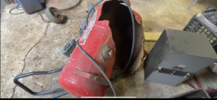The rust question is a good one.
If you've been taking good care of your tank, with the noted exception of not properly draining the water when you should, you're not likely to have a problem. If your picture showed signs of damage/abuse externally, I'd be more concerned.
You're not running a high pressure air compressor, capable of refilling dive tanks or some such. Not saying a catastrophic failure wouldn't be dangerous, but you're not like to get a catastrophic failure.
What you'll get are leaks, which you'll likely notice at first by the compressor not being able to maintain pressure and the motor cycling more and more often. If this happens, and it's not due to joint leakage or some such and is isolated to the tank, then it's time for a new compressor.
ALL of these types of compressors WILL gather moisture inside them because none of them are set up with an air dryer for the intake.
Most air compressors people use don't do this...because they don't need to. Really high pressure air systems, however, may do this for various reasons. For example, the High Pressure Air Compressors (HPACs) on submarines do this because it's critical that the air in submarine systems be dry for several reasons. One is that the 4,500 pound air banks responsible for the emergency blow system could quite literally "ice up" piping and valves internally and block air flow in the precious seconds the system is required to work when performing an emergency blow to bring the ship up to the surface during a casualty. (In fact, this may have been a significant contributing factor to the loss of the USS Thresher during sea trials in 1963.)
Consequently, most common compressed air systems where moisture isn't that critical deals with this by periodically purging from tanks by venting at a low point and dry air necessities are typically attended to with the air as it's being used (from the tanks as opposed to when it's being initially compressed).
So you are ALWAYS going to have moisture in your tank...with compressed air (including oxygen). Some amount of corrosion will ALWAYS occur, whether you have only "condensation" in the tank or whether you actually get some kind of pool of water inside the tank.
If you REALLY want to know if the tank is capable of safely handling maximum operating pressure, then have it hydro tested. Probably cost you a bit under a hundred bucks to have this done. You can also do this yourself, but you have to understand what you're doing and WHY you're doing it the way it's supposed to be done.
First of all, for such low pressure air compressor systems, the hydro test pressure is typically going to be about 50% greater than your maximum operating pressure (NOT whatever your safety relief valve pressure is set at). The picture you posted leads me to believe your maximum operating pressure is 175 PSI. Hydro test pressure would then be 262.5 PSI. Tolerance on this is typically+/- 10%.
Second, it's called a HYDROSTATIC test for a reason...you use water to do the test and not air. Why? Because water is not compressible like air. If you used nothing but air to do this test, you'd be packing a LOT of air into that tank to get it up to test pressure...if the tank leaks or ruptures, then you will have a LOT of air escaping, which can cause a lot of damage. When you fill the tank completely up with water, however, this doesn't happen: water isn't compressible. Once it's full, only a tiny amount of additional water is required to cause a large change in pressure. If a leak or rupture occurs, then only a small amount of water under pressure will leak out and the tank pressure will immediately drop to atmospheric pressure in that instant.
If the tank holds hydro pressure for five minutes, it's good.
There are other tests that are performed on some tanks during a hydro, such as a deformation test. In this case, the tank under test is submerged in a tank of water and the level noted. When raising pressure in the tank being tested, the monitor water level to be sure the tank isn't swelling or bulging as they increase pressure.




